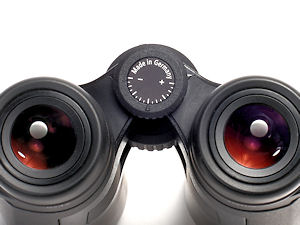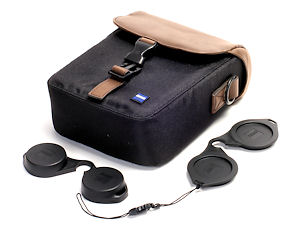Zeiss Victory HT Binoculars
|
|
Review Highlights
- Zeiss’ latest entry in the superb Victory line
- Even brighter than the old Victory FLs
- Better ergonomics, wider field of view
|
When Zeiss announced that they were bringing an end to their very successful Victory FL
binocular line, we half wondered if they knew what they were doing. After all, the FLs were fantastic;
arguably the brightest binocular on the market, with a great field of view and decent ergonomics. Serious sportsmen,
wildlife watchers, tour guides and birders all around the world carry this binocular. We heard about the replacement: the Victory HT,
and we wondered what it would be like. Well, the HTs are here, and it can now be confirmed that Zeiss knew exactly what they were doing!
The HTs were really worth the wait because they are fabulous! They are, if anything, even brighter than the FLs, and that’s just the beginning.
As of this time of writing, Zeiss Victory HT binoculars are only available in 8x42 and 10x42 models.
Physical Characteristics
Zeiss Victory HT binoculars are roof prism binoculars, and like all high-end roof prisms,
they are completely sealed and nitrogen-purged, so they are waterproof, internally fog-proof and dust-proof.
Like the FLs before them, the HT’s use the same Abbe-Konig prism array inside. One consequence of this design
is that the HTs are a bit taller than most other 42-mm roof prisms. The HTs stand 7 inches tall with the eyecups
fully extended, and 5.6 inches wide with the hinge fully open. Of course, the upside is that they are also extremely
bright, but we’ll get to that later! High density glass and substantial rubber armoring also mean that the HTs are
a bit on the hefty side. Zeiss countered by switching to magnesium for the chassis which is lighter and stronger than
the aluminum usually used for this. Despite that our postal scale put the HTs at 30.9 oz. for the 8x42 model
(this weight includes the objective lens caps and the rainguard – they weigh 29.5 oz. without those). The 10x42 model
is slightly heavier at 31.7 oz. (30.2 oz. without the caps). This seems like a lot, but there are some mitigating factors.
The major rubber armoring on the HTs protects against bumps and drops, and increases the comfort of these binoculars in
the hand. There is a ridge on the outside of the barrel that just fits beautifully right where your fingers bend. The HTs
are beautifully balanced, making them feel lighter than they actually are. We still recommend that you purchase a harness
strap and remember that once you hold the HTs up to your eyes, you’ll have plenty to distract you from their weight. Among
the other physical properties you might want to know about: the HTs have a particularly broad interpupilary distance range
of 54-76 mm, meaning they will comfortably fit nearly anyone’s face.
Optical Properties
The overwhelming optical characteristic of the HTs is brightness – we’ve never seen anything quite like these.
Zeiss claims that the HTs have 95% light transmission, meaning 95% of the light that hits the objectives makes
it through to your eyes. We don’t have any way to measure that, but what we do know is that these binoculars
are indeed incredibly bright. Moreover, it’s brightness that comes with vivid color and excellent contrast,
so that the quality of view is simply seductive. There’s no way to describe that brightness, but we can
illustrate it. Two of us were out birding at dusk one evening when a large group of geese flew in to the
pond in front of us. The one of us using the Victory HTs could easily pick out the 3 Greater White-fronted
Geese mixed in with the Canadas as they splashed in for a landing. Once on the pond, where it was even darker,
the HTs were still easily picking out the three different geese. The other person was using Victory FLs and
couldn’t make them out, but when we exchanged binoculars, there they were! Simply put, the light throughput of
the HTs is so good that it allows you to see things that even other excellent binoculars just can’t pick out.
That kind of seeing makes a believer out of you! The 10x Victory HT binoculars have the same 330-foot field of
view at 1000 yards as the old FLs, but the 8x42 HTs have a much larger 408-foot field of view (compared to 360
feet for the 8x42 FLs). This is a dramatic improvement, and it puts them well ahead of most 8x42 roof prisms
in this regard. Both models close focus to just under 6 feet, which is very good performance for this characteristic.
Eye relief on both models is a solid 16 mm, which is enough for most users. The HTs have slightly better than
average depth of field and average field curvature. We feel that the HTs have better field edge performance than
the FLs did. That “soft” portion of view at the field edge is smaller on the HTs than it was on the FLs. The HTs
also are notably better than average on color aberration, which is to say we see less of it. All binoculars
show it to some degree or other; all you can hope for is that it is limited to the field edges and generally
minimal in extent, which is exactly what we see on the HTs.
User Adjustments
 |
|
Click image to enlarge
|
The first and foremost user adjustment is focusing. Zeiss Victory HT binoculars have a large central
focus knob covered in pliable rubber armoring with nice grooves in it for better traction. The action
of this knob is incredibly smooth and easy with very little resistance. This is actually one of the very
first things that jumps out at you when you handle this binocular. If you like a smooth focus action,
this one is perfect! We note that it takes 1.75 turns of the knob to go from minimum close focus to infinity,
which is a little on the long side, but not annoyingly so. What this translates to is very precise focusing
in the field, which is a good thing! The eyecups adjust with the standard helical twist action, clockwise
to close them down, counter-clockwise to open them up. There are two fully-stable positions intermediate
between fully in and fully out, and all four positions are marked by firm detents. They show very little
tendency to collapse in the field. This is a really great eyecup mechanism! The diopter adjustment is a small
rubber knob on the ocular side of the bridge. The rubber ring has a triangle that lines up with a white scale
on the round knob, with a series of gradations marking plus or minus positions away from equal. The mechanism
does not lock, and it does occasionally get knocked out of position in the field, though not often. We used
these binoculars a lot during field testing, and had the diopter setting jostled just twice during that time.
What this means is, if you need a position away from equal, you might want to mark the dial in some way to
preserve that position, so you don’t have to go through the process of re-finding it if it gets lost. This
was an interesting design choice by Zeiss, but it’s still a reasonably effective one.
Glass and Coatings
An integral part of the light transmission equation is the glass and coatings, and in this case, it’s
particularly significant. Lenses on the Victory HT binoculars are made with high performance fluoride
glass manufactured by Schott. The prisms are made of BaK-4 glass, which is pretty much industry standard.
Zeiss HT binoculars are fully multi-coated with Zeiss’ proprietary T* coating on all interior surfaces.
The multi-coating is designed to enhance light transmission, maximize color fidelity, and minimize distortion
and color aberration. Zeiss also adds their Lotu-Tec coating on the lens surfaces, which makes the binocular
shed water very efficiently. As it happens, the same coating that makes water bead up and run lightly off also
makes it harder for dust and dirt to adhere to the lenses, so you don’t have to clean them as often, and when you
do, they are easier to clean. There is a tremendous amount of technology in both the glass and the coatings, and
while it’s true that every company has their own proprietary versions of these, it’s not true that all of them are
equally effective. It is worth noting that, historically, Zeiss has been at the cutting edge of developing and applying
coatings to their glass, and that their coatings have always been among the best in the business.
Caps, Strap and Case
 |
|
Click image to enlarge
|
The rainguard on the Victory HTs is a pair of pliable black rubber cups linked by a flexible bridge.
Each side has a bracket for the strap to slide through. The cups fit deeply and snugly over the eyecups
of the binoculars, and while easy to put on, they don’t come off even when the binocular is inverted and
shaken. We can tell you that this is a dramatic improvement on the old FL rainguard, which was forever
falling off. This one stays in place until you take it off, which is just how you want it. With the objective
lens caps, Zeiss went the other way. The old FL objective caps were tethered to rings that fit around the barrels.
Those sometimes fell off the barrels, it’s true, but when they were in place, they didn’t come off and worked well.
The Victory HT objective caps are a single unit comprised of shallow-rimmed cups that fit inside the rim of the
objective lenses. They’re a bit difficult to get in place, and there are little loops on the edge of the cups that
always catch on something and rip off the objective cover. Honestly, the tethered caps were a better solution.
The strap that comes with the Victory HT binoculars is fairly standard: a contoured leather and cordura design.
It’s comfortable enough, but as noted earlier, we recommend using a harness strap with these. The HT binocular case
is quite nice. It’s made of water-resistant cordura, well cushioned, and features a leather flap that closes over
the binocular with a double-toothed clasp. The case is big enough for the binocular even with the eyecups fully extended,
and it’s easy to close it around the straps, so you can carry the binocular by its own straps while it’s in the case.
The case also comes with a strap of its own.
Conclusions
We think the Zeiss Victory HT is a fabulous binocular, whether you want to use it for birding, hunting,
or general nature watching. The brightness and clarity of the view is breath-taking, the ergonomics are
excellent, and the ease of use is superb. The 8x42 HT is priced at
$2,349.99, while the 10x42 HT sells for
$2,399.99.
We carried these in the field for weeks during the assessment, and now our only problem is that we have to give them back.
In 2017, Zeiss added 8x54 and 10x54 models of the Victory HT. The ultra-high transmission rate allowed Zeiss to deliver
a brighter image than competitors' 56mm entries, and reduce the weight to less than 37oz. In 2018, they discontinued the
42mm models. The link below will take you to the 54mm models.
Buy Zeiss Victory HT Binoculars